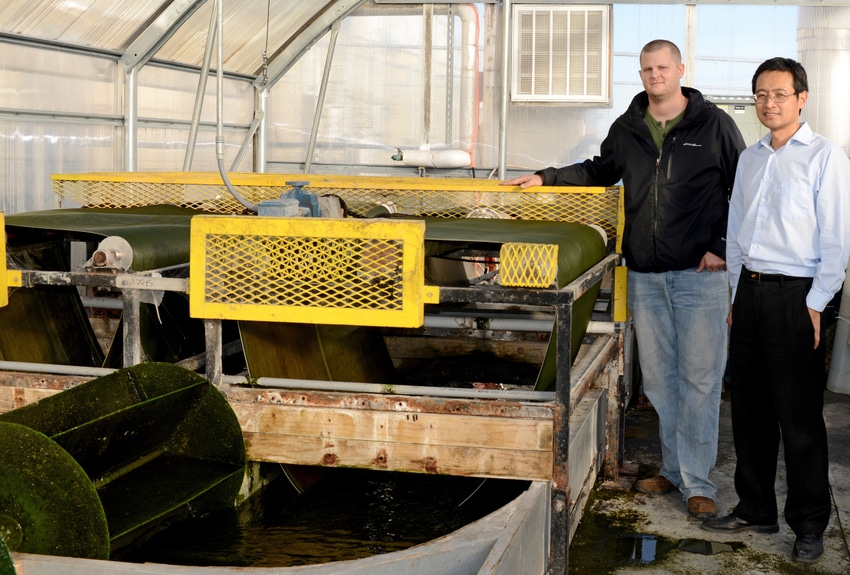Algae technology helps treat wastewater
System uses vertical conveyor belts that revolve in continual loop, cycling through wastewater and air as multiple layers of algae grow on them.
January 25, 2017

Iowa State University technology that improves the efficiency of wastewater reclamation using algae has gotten the attention of small Iowa communities and the largest wastewater treatment system in the world.
“This reactor greatly improves the efficiency of carbon dioxide and sunlight absorption. We found that the biomass productivity is about 10 times higher than a conventional system,” said Zhiyou Wen, professor of food science and human nutrition who developed the system with Martin Gross, a postdoctoral fellow in the Center for Crops Utilization Research.
The system uses vertical conveyor belts that are about 6 ft. tall and 3 ft. wide and revolve in a continual loop, cycling through the wastewater and air as multiple layers of algae grow on them.
The Metropolitan Water Reclamation District of Greater Chicago, Ill., has tested the Revolving Algal Biofilm treatment system. It has finished a yearlong study treating waste streams from one of its water reclamation plants and extended the research project another year because of promising results.
Algae absorbs phosphorus and nitrogen from the wastewater, along with carbon dioxide from the air. Wastewater is typically treated with a bacterial process that produces sludge, which creates odor and disposal issues.
The algae produced from this new process can be harvested, pelletized and used as a sustainable fertilizer. Wen and Gross have started a company, Gross-Wen Technologies, that obtained a Small Business Innovation Research grant from the U.S. Department of Agriculture to develop the algae-based fertilizer. Gross serves as chief executive officer of the company.
Wen and Gross also produced a mobile version of the system that can travel to communities and businesses around Iowa.
“Instead of inviting a local community’s water treatment personnel to come to our (Iowa State) facility to perform water treatment tests, we built this trailer to take to the community to treat wastewater on site,” Wen said.
The trailer was recently taken to Dallas Center, Iowa, for a project at its water treatment facility.
Wen said communities in Iowa are facing more restrictive regulations for the removal of nutrients like nitrogen and phosphorus from wastewater, likely requiring costly treatment facility upgrades that could be avoided by instead implementing the algae system. About 500 small communities in Iowa could be affected by the new regulations. He said these communities are looking at treatment system upgrades that could cost as much as $5 million, which is a huge burden on these small towns.
“So, that’s the niche for us. We have this algae cultivation system that can help these communities meet their new nutrient limits at a fraction of the cost of other systems,” Wen said.
The trailer also was recently used to test the system at CJ Bio America, a feed supplement company in Ft. Dodge, Iowa. The test generated data to determine the cost of implementing the algae system at the plant.
You May Also Like



